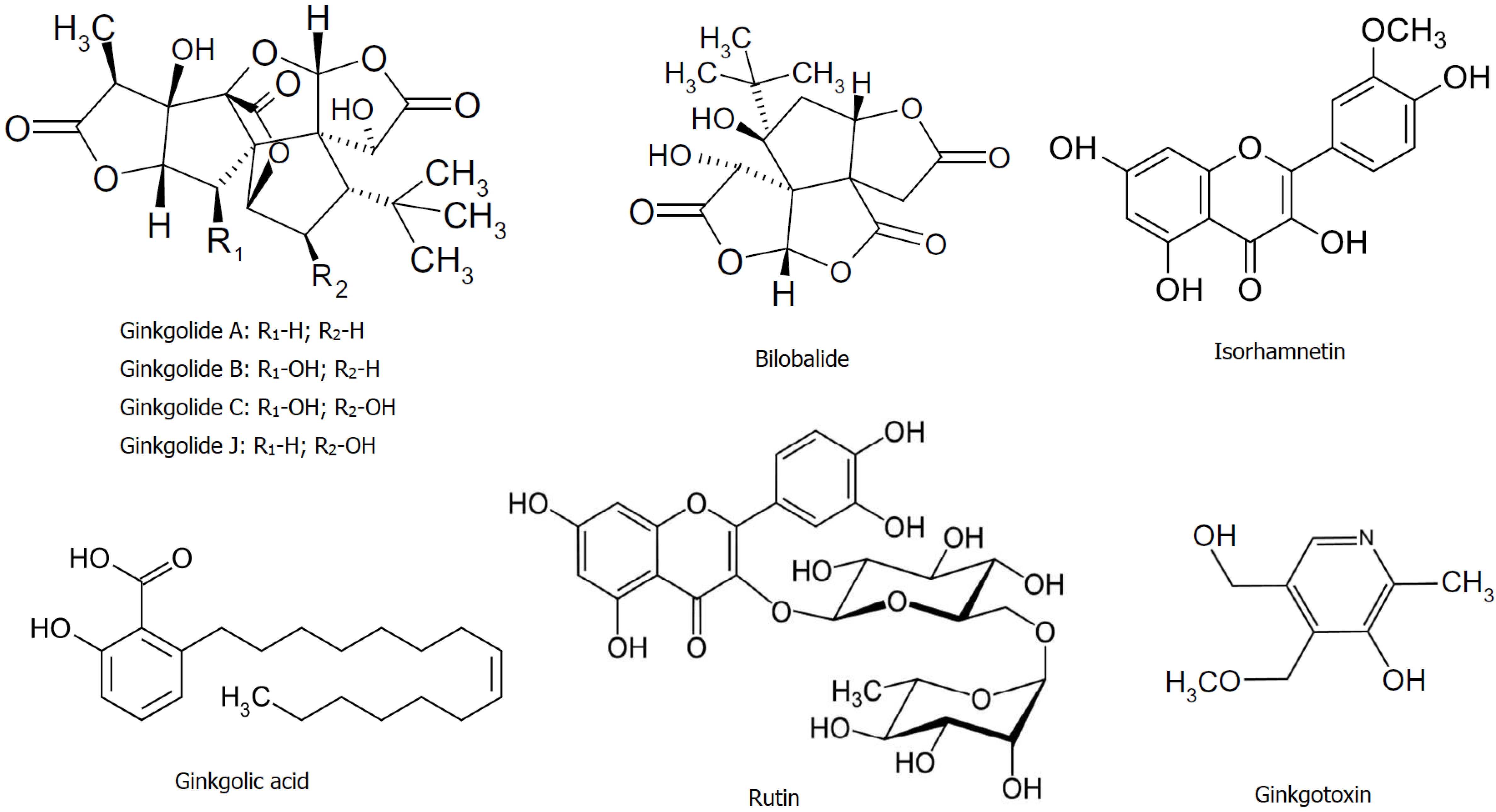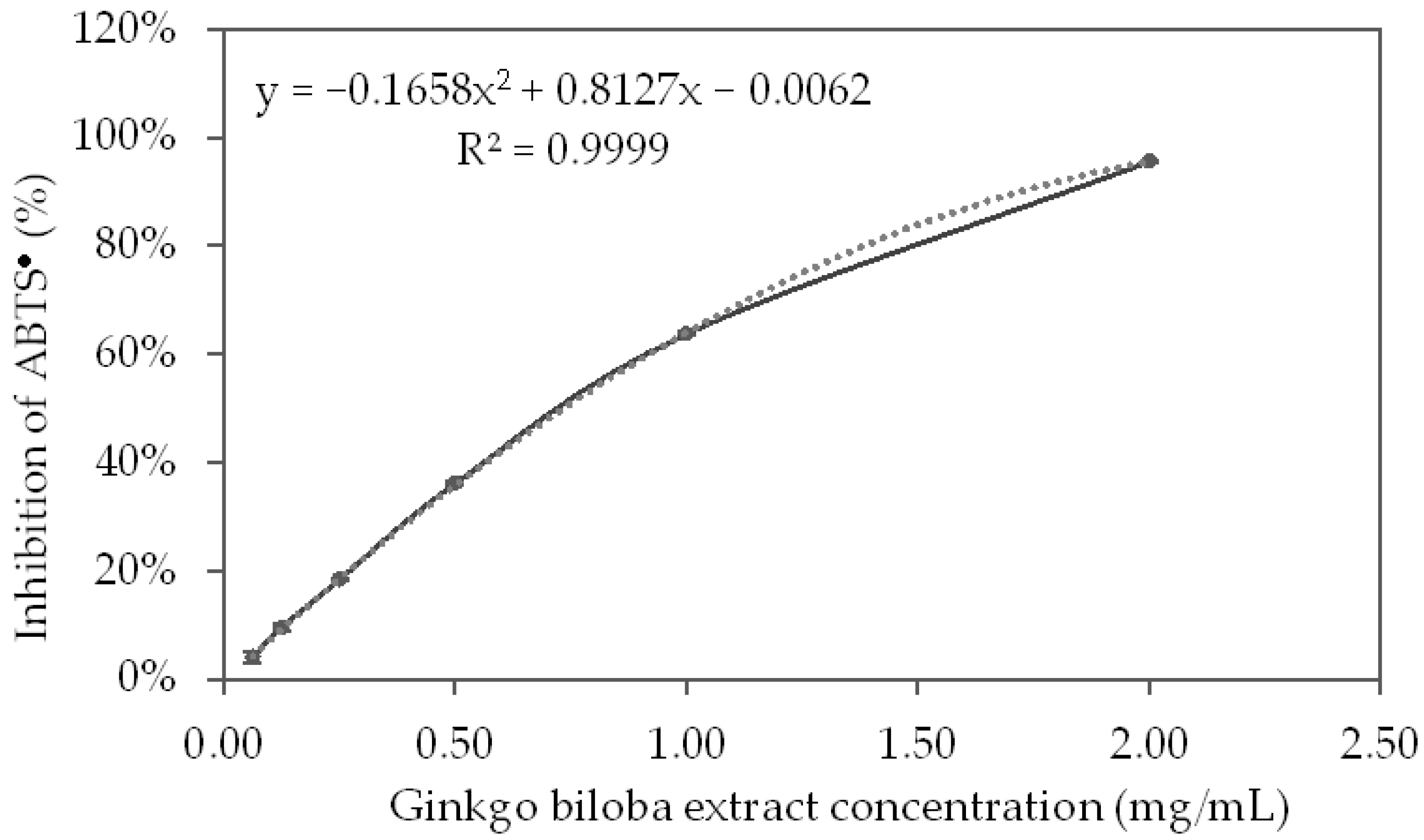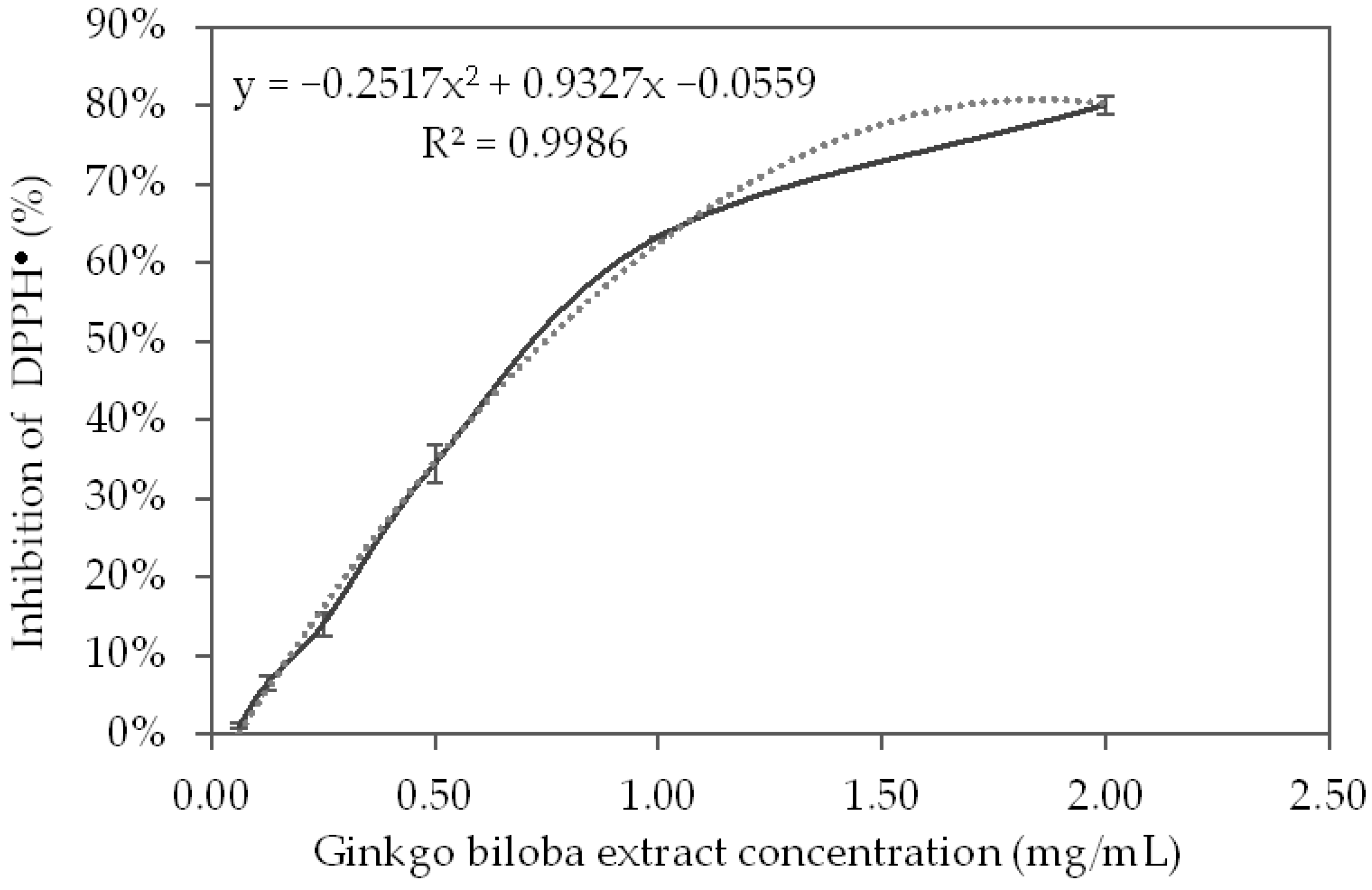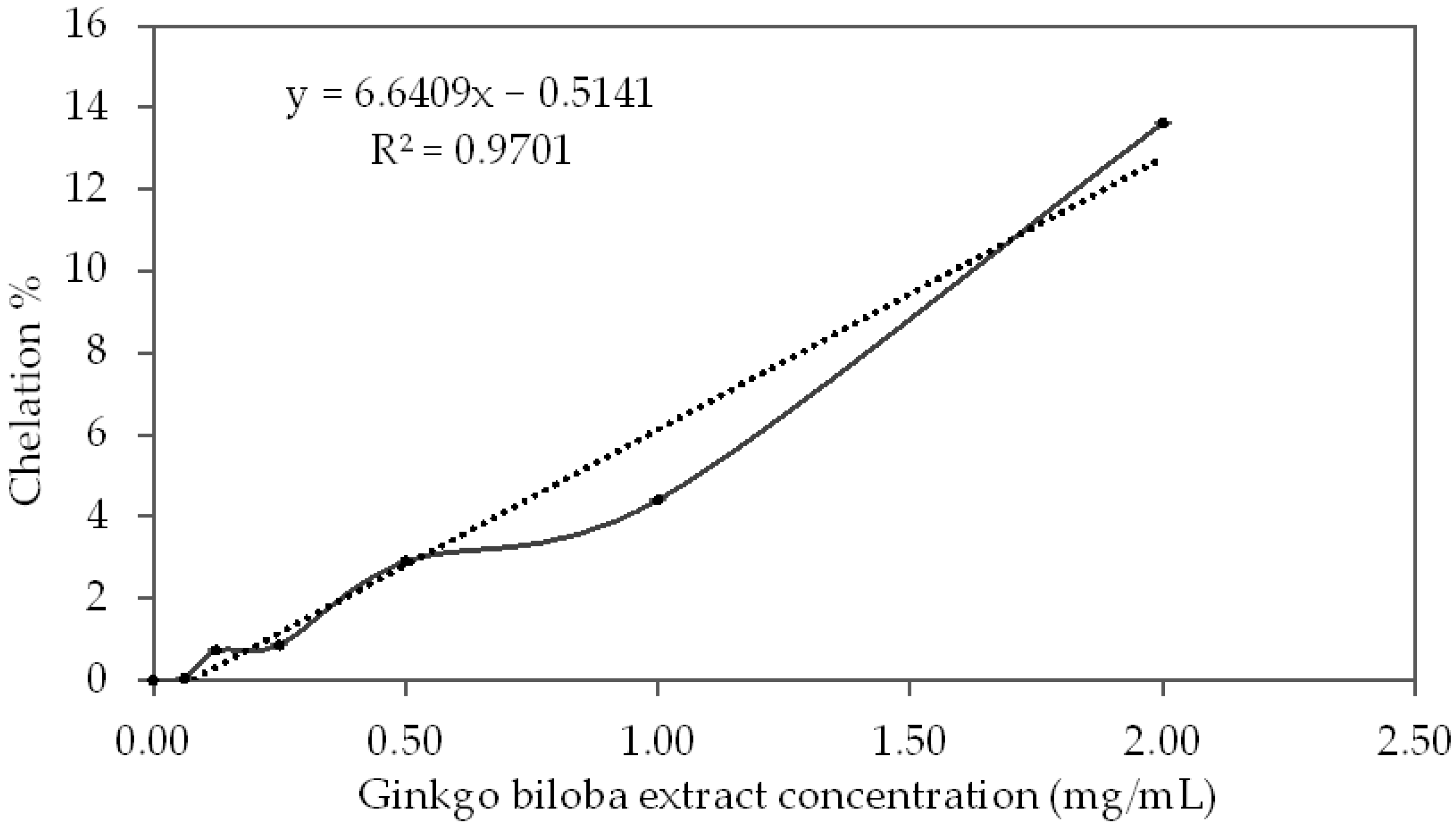Chromatographic Profile and Redox-Modulating Capacity of Methanol Extract from Seeds of Ginkgo biloba L. Originating from Plovdiv Region in Bulgaria
Abstract
:1. Introduction
2. Materials and Methods
2.1. Preparation of Ginkgo biloba Seed Extract (GBSE)
2.2. Chromatographic Determination of GBSE Composition
2.3. ABTS•+ Assay
2.4. DPPH Assay
2.5. FRAP Assay
2.6. CUPRAC Assay
2.7. Metal Chelating Assay
2.8. Statistics
3. Results
3.1. Chromatographic Determination of GBSE Composition
3.2. ABTS-Radical-Scavenging Properties
3.3. DPPH-Radical-Scavenging Properties
3.4. FRAP Assay
where x is FeSO4 concentration (mmol/L) (R2 = 0.9967)
3.5. Cupric Reducing Antioxidant Capacity—CUPRAC
where x is Trolox concentration (µmol/L) (R2 = 0.9981)
3.6. Metal Chelation Capacity
x is the EDTA concentration (mM)
4. Discussion
5. Conclusions
Supplementary Materials
Author Contributions
Funding
Institutional Review Board Statement
Informed Consent Statement
Data Availability Statement
Conflicts of Interest
References
- Ivanova, V.; Natcheva, L.; Gercheva, P. Use of Ginko biloba, L. in green system of the town of Plovdiv. In Proceedings of the Scientific Works of the Union of Scientists in Bulgaria-Plovdiv, Plovdiv, Bulgaria, 5–6 November 2015; pp. 241–244. [Google Scholar]
- Zhang, Z.; Chen, S.; Mei, H.; Xuan, J.; Guo, X.; Couch, L.; Mei, N. Ginkgo biloba leaf extract induces DNA damage by inhibiting topoisomerase II activity in human hepatic cells. Sci. Rep. 2015, 5, 14633. [Google Scholar] [CrossRef] [PubMed] [Green Version]
- Goh, L.M.; Barlow, P.J. Antioxidant capacity in Ginkgo Biloba. Food Res. Int. 2002, 35, 815–820. [Google Scholar] [CrossRef]
- Tomova, T.; Doncheva, N.; Mihaylova, A.; Kostadinov, I.; Peychev, L.; Argirova, M. An experimental study on phytochemical composition and memory enhancing effect of Ginkgo biloba seed extract. Folia Med. 2021, 63, 203–212. [Google Scholar] [CrossRef] [PubMed]
- Wonther, K.; Randlov, C.; Rein, E.; Mehlsen, J. Effects of Ginkgo boloba extracts on cognitive function and blood presure in elderly subjects. Curr. Ther. Res. 1998, 59, 881–888. [Google Scholar] [CrossRef]
- Diamond, B.J.; Shiflett, S.C.; Feiwel, N.; Matheis, R.J.; Noskin, O.; Richards, J.A.; Schoenberger, N.E. Ginkgo biloba extract: Mechanisms and clinical indications. Arch. Phys. Med. Rehabil. 2000, 81, 668–678. [Google Scholar] [CrossRef]
- Yuan, Q.; Wang, C.W.; Shi, J.; Lin, Z.X. Effects of Ginkgo biloba on dementia: An overview of systematic reviews. J. Ethnopharmacol. 2017, 195, 1–9. [Google Scholar] [CrossRef] [PubMed]
- Zeng, K.; Li, M.; Hu, J.; Mahaman, Y.A.; Bao, J.; Huang, F.; Wang, X. Ginkgo biloba extract EGb761 attenuates Hyperhomocysteinemia-induced AD like tau hyperphosphorylation and cognitive impairment in rats. Curr. Alzheimer Res. 2018, 15, 89–99. [Google Scholar] [CrossRef]
- Tanaka, K.; S-Galduroz, R.F.; Gobbi, L.T.B.; Galduróz, J.C.F. Ginkgo biloba extract in an animal model of Parkinson’s disease: A systematic review. Curr. Neuropharmacol. 2013, 11, 430–435. [Google Scholar] [CrossRef] [Green Version]
- Kumar Singh, S.; Barreto, G.E.; Aliev, G.; Echeverria, V. Ginkgo biloba as an alternative medicine in the treatment of anxiety in dementia and other psychiatric disorders. Curr. Drug Metab. 2017, 18, 112–119. [Google Scholar] [CrossRef]
- Tian, J.; Liu, Y.; Chen, K. Ginkgo biloba extract in vascular protection: Molecular mechanisms and clinical applications. Curr. Vasc. Pharmacol. 2017, 15, 532–548. [Google Scholar] [CrossRef]
- Zhou, W.; Chai, H.; Lin, P.H.; Lumsden, A.B.; Yao, Q.; Chen, C. Clinical use and molecular mechanisms of action of extract of Ginkgo biloba leaves in cardiovascular diseases. Cardiovasc. Drug Rev. 2004, 22, 309–319. [Google Scholar] [CrossRef] [PubMed] [Green Version]
- Liu, Q.; Jin, Z.; Xu, Z.; Yang, H.; Li, L.; Li, G.; Xiao, W. Antioxidant effects of ginkgolides and bilobalide against cerebral ischemia injury by activating the Akt/Nrf2 pathway in vitro and in vivo. Cell Stress Chaperones 2019, 24, 441–452. [Google Scholar] [CrossRef] [PubMed]
- Yoshikawa, T.; Naito, Y.; Kondo, M. Ginkgo biloba leaf extract: Review of biological actions and clinical applications. Antioxid. Redox Signal. 1999, 1, 469–480. [Google Scholar] [CrossRef] [PubMed]
- Mohanta, T.K.; Tamboli, Y.; Zubaidha, P.K. Phytochemical and medicinal importance of Ginkgo biloba L. Nat. Prod. Res. 2014, 28, 746–752. [Google Scholar] [CrossRef] [PubMed]
- Liu, L.; Wang, Y.; Zhang, J.; Wang, S. Advances in the chemical constituents and chemical analysis of Ginkgo biloba leaf, extract, and phytopharmaceuticals. J. Pharm. Biomed. Anal. 2021, 193, 113704. [Google Scholar] [CrossRef] [PubMed]
- Avula, B.; Sagi, S.; Gafner, S.; Upton, R.; Wang, Y.H.; Wang, M.; Khan, I.A. Identification of Ginkgo biloba supplements adulteration using high performance thin layer chromatography and ultra high performance liquid chromatography-diode array detector-quadrupole time of flight-mass spectrometry. Anal. Bioanal. Chem. 2015, 407, 7733–7746. [Google Scholar] [CrossRef]
- Santos-Sánchez, N.F.; Salas-Coronado, R.; Villanueva-Cañongo, C.; Hernández-Carlos, B. Antioxidant compounds and their antioxidant mechanism. Antioxidants 2019, 10, 1–29. [Google Scholar]
- Di Domenico, F.; Barone, E.; Perluigi, M.; Butterfield, D.A. Strategy to reduce free radical species in Alzheimer’s disease: An update of selected antioxidants. Expert Rev. Neurother. 2015, 15, 19–40. [Google Scholar] [CrossRef]
- Simons, B.D.; Clevers, H. Strategies for homeostatic stem cell self-renewal in adult tissues. Cell 2011, 145, 851–862. [Google Scholar] [CrossRef] [Green Version]
- Wang, K.; Zhang, T.; Dong, Q.; Nice, E.C.; Huang, C.; Wei, Y. Redox homeostasis: The linchpin in stem cell self-renewal and differentiation. Cell Death Dis. 2013, 4, e537. [Google Scholar] [CrossRef] [Green Version]
- Schlesier, K.; Harwat, M.; Böhm, V.; Bitsch, R. Assessment of antioxidant activity by using different in vitro methods. Free Radic. Res. 2002, 36, 177–187. [Google Scholar] [CrossRef] [PubMed]
- Halliwell, B.; Gutteridge, J.M. Free Radicals in Biology and Medicine; Oxford University Press: Oxford, MS, USA, 2015. [Google Scholar]
- Re, R.; Pellegrini, N.; Proteggente, A.; Pannala, A.; Yang, M.; Rice-Evans, C. Antioxidant activity applying an improved ABTS radical cation decolorization assay. Free. Radic. Biol. Med. 1999, 26, 1231–1237. [Google Scholar] [CrossRef]
- Brand-Williams, W.; Cuvelier, M.E.; Berset, C. Use of a free radical method to evaluate antioxidant activity. LWT—Food Sci. Technol. 1995, 28, 25–30. [Google Scholar] [CrossRef]
- Benzie, I.F.F.; Strain, J.J. The ferric reducing ability of plasma (FRAP) as a measure of ‘antioxidant power’: The FRAP assay. Anal. Biochem. 1996, 239, 70–76. [Google Scholar] [CrossRef] [PubMed] [Green Version]
- Apak, R.; Güçlü, K.; Özyürek, M.; Karademir, S.E. Novel total antioxidant capacity index for dietary polyphenols and vitamins C and E, using their cupric ion reducing capability in the presence of neocuproine: CUPRAC method. J. Agric. Food Chem. 2004, 52, 7970–7981. [Google Scholar] [CrossRef] [PubMed]
- Venditti, E.; Bacchetti, T.; Tiano, L.; Carloni, P.; Greci, L.; Damiani, E. Hot vs. cold water steeping of different teas: Do they affect antioxidant activity? Food Chem. 2010, 119, 1597–1604. [Google Scholar] [CrossRef]
- Özyürek, M.; Güçlü, K.; Tütem, E.; Başkan, K.S.; Erçağ, E.; Çelik, S.E.; Apak, R. A comprehensive review of CUPRAC methodology. Anal. Methods 2011, 3, 2439–2453. [Google Scholar] [CrossRef]
- Sati, P.; Dhyani, P.; Bhatt, I.D.; Pandey, A. Ginkgo biloba flavonoid glycosides in antimicrobial perspective with reference to extraction method. J. Tradit. Complementary Med. 2019, 9, 15–23. [Google Scholar] [CrossRef]
- Ražná, K.; Sawinska, Z.; Ivanišová, E.; Vukovic, N.; Terentjeva, M.; Stričík, M.; Kačániová, M. Properties of Ginkgo biloba L.: Antioxidant characterization, antimicrobial activities, and genomic microRNA based marker fingerprints. Int. J. Mol. Sci. 2020, 21, 3087. [Google Scholar] [CrossRef]
- Tzanova, M.; Grozeva, N.; Gerdzhikova, M.; Argirova, M.; Pavlov, D.; Terzieva, S. Flavonoid content and antioxidant activity of Betonica bulgarica Degen et Neič. Bulg. Chem. Commun. 2018, 50, 90–97. [Google Scholar]
- van Beek, T.A.; Montoro, P. Chemical analysis and quality control of Ginkgo biloba leaves, extracts, and phytopharmaceuticals. J. Chromatogr. A 2009, 1216, 2002–2032. [Google Scholar] [CrossRef] [PubMed]
- McKeage, K.; Lyseng-Williamson, K.A. Ginkgo biloba extract EGb 761® in the symptomatic treatment of mild-to-moderate dementia: A profile of its use. Drugs Ther. Perspect. 2018, 34, 358–366. [Google Scholar] [CrossRef] [PubMed] [Green Version]
- Guo, Y.; Mao, M.; Li, Q.; Yu, X.; Zhou, L. Extracts of Ginkgo flavonoids and ginkgolides improve cerebral ischaemia-reperfusion injury through the PI3K/Akt/Nrf2 signalling pathway and multicomponent in vivo processes. Phytomedicine 2022, 99, 154028. [Google Scholar] [CrossRef] [PubMed]
- Omar, S.H. Ginkgolides and Neuroprotective Effects; Springer: Berlin/Heidelberg, Germany, 2013. [Google Scholar]
- Yang, J.; Guo, J.; Yuan, J. In vitro antioxidant properties of rutin. LWT-Food Sci. Technol. 2008, 41, 1060–1066. [Google Scholar] [CrossRef]
- Gong, G.; Guan, Y.Y.; Zhang, Z.L.; Rahman, K.; Wang, S.J.; Zhou, S.; Zhang, H. Isorhamnetin: A review of pharmacological effects. Biomed. Pharmacother. 2020, 128, 110301. [Google Scholar] [CrossRef] [PubMed]
- Xu, D.; Hu, M.J.; Wang, Y.Q.; Cui, Y.L. Antioxidant activities of quercetin and its complexes for medicinal application. Molecules 2019, 24, 1123. [Google Scholar] [CrossRef] [PubMed] [Green Version]
- Xiao, Z.; He, L.; Hou, X.; Wei, J.; Ma, X.; Gao, Z.; Yue, T. Relationships between structure and antioxidant capacity and activity of glycosylated flavonols. Foods 2021, 10, 849. [Google Scholar] [CrossRef]
- Zuo, A.; Yanying, Y.; Li, J.; Binbin, X.; Xiongying, Y.; Yan, Q.; Shuwen, C. Study on the relation of structure and antioxidant activity of isorhamnetin, quercetin, phloretin, silybin and phloretin isonicotinyl hydrazone. Free Radic. Antioxid. 2011, 1, 39–47. [Google Scholar] [CrossRef] [Green Version]
- Wada, K.; Ishigaki, S.; Ueda, K.; Take, Y.; Sasaki, K.; Sakata, M.; Haga, M. Studies on the Constitution of Edible and Medicinal Plants. I.: Isolation and Identification of 4-O-Methylpyridoxine, Toxic Principle from the Seed of Ginkgo biloba L. Chem. Pharm. Bull. 1988, 36, 1779–1782. [Google Scholar] [CrossRef] [Green Version]
- Ahlemeyer, B.; Selke, D.; Schaper, C.; Klumpp, S.; Krieglstein, J. Ginkgolic acids induce neuronal death and activate protein phosphatase type-2C. Eur. J. Pharmacol. 2001, 430, 1–7. [Google Scholar] [CrossRef]
- Zeb, A. Concept, mechanism, and applications of phenolic antioxidants in foods. J. Food Biochem. 2020, 44, e13394. [Google Scholar] [CrossRef] [PubMed]
- Park, J.S. Analysis of Antioxidant Efficacy of Ginkgo Biloba Leaves and Acer Palmatum Leaves. Turk. J. Comput. Math. Educ. (TURCOMAT) 2021, 12, 698–703. [Google Scholar] [CrossRef]
- El-Beltagi, H.S.; Badawi, M.H. Comparison of antioxidant and antimicrobial properties for Ginkgo biloba and rosemary (Rosmarinus officinalis L.) from Egypt. Not. Bot. Horti Agrobot. Cluj-Napoca 2013, 41, 126–135. [Google Scholar] [CrossRef] [Green Version]
- Ahmad, N.; Fazal, H.; Abbasi, B.H.; Farooq, S. Efficient free radical scavenging activity of Ginkgo biloba, Stevia rebaudiana and Parthenium hysterophorous leaves through DPPH (2, 2-diphenyl-1-picrylhydrazyl). Int. J. Phytomed. 2010, 2, 231–239. [Google Scholar]






| Analyte | Column | Mobile Phase | Gradient | Flow Rate [mL/min] | HESI-Ionizator Mode | Collision Energy [eV] | Scan Mode |
|---|---|---|---|---|---|---|---|
| Flavonoids | Syncronis C18 (150 × 4.6 mm, 5 µm); Thermo Fisher Scientific Inc., Waltham, MA, USA | А–0.1% HCOOH in МeCN–H2O (90:10, v/v) B–0.1% HCOOH in МeCN–H2O (10:90, v/v) | 0–3 min–70% B, 3–10 min–42.5% B, 10–11 min–17.5% B, 11–19 min–0% B, 19–25 min–80% B | 0.7 | Negative | 32 24 27 31 | SRM |
| Terpen trilactones | Syncronis C18 (150 × 4.6 mm, 5 µm); Thermo Fisher Scientific Inc., Waltham, MA, USA | 0.1% HCOOH in MeCN-H2O (50:50, v/v) | Isocratic | 0.5 | Negative | 14 16 17 18 14 | SRM |
| Ginkgolic Acid C13:0 | Syncronis C18 (150 × 4.6 mm, 5 µm); Thermo Fisher Scientific Inc., Waltham, MA, USA | A-100% MeCN + 0.1% HCOOH B-10% MeCN + 0.1% HCOOH | 0 min–30% B, 0–5 min–0 % B, 5–14 min–0% B, 14–25 min–30% B | 1.0 | Negative | 23 | SRM |
| Ginkgotoxin | Hypersil C18 (150 × 3 mm, 3 µm); Thermo Hypersil-Keystone Corp., Waltham, MA, USA | А-0.1% HCOOH in MeCN-H2O (60:40, v/v) B–0.1% HCOOH in МeCN–H2O (10:90, v/v) | Reverse gradient 0–1 min–80% B, 1–6 min–20% B, 6–15 min–10% B, 15–20 min–80% B | 0.5 | Positive | 13 | SRM |
| № | Compound Name | Formula | RT [min] | Molecular Mass | Q1 ⟶ Q3 (m/z) | Detected Amount [µg/g] | |
|---|---|---|---|---|---|---|---|
| Flavonoids | 1. | Rutin | C27H30O16 | 3.36 | 610.50 | 609.2 ⟶ 300.5 | 27.59 |
| 2. | Quercetin | C15H10O7 | 6.87 | 302.04 | 300.9 ⟶ 151.1 | 0.12 | |
| 3. | Kaempferol | C15H10O6 | 8.02 | 286.05 | 285 ⟶ 185.1 | ND * | |
| 4. | Isorhamnetin | C16H12O7 | 8.23 | 316.06 | 315 ⟶ 151 | 1.26 | |
| Terpenes | 5. | Ginkgolide A | C20H24O9 | 5.67 | 408.14 | 453 ⟶ 407 | 104.67 |
| 6. | Ginkgolides B, J | C20H24O10 | 5.66 | 424.14 | 423 ⟶ 367.5 | 221.44 | |
| 7. | Ginkgolide C | C20H24O11 | 3.79 | 440.13 | 439 ⟶ 383.02 | 47.52 | |
| 8. | Bilobalide | C15H18O8 | 5.25 | 326.10 | 324.9 ⟶ 163.0 | 103.69 | |
| 9. | Ginkgolic Acid C13:0 | C22H34O3 | 12.08 | 346.50 | 319.2 ⟶ 275.3 | 3.90 | |
| 10. | Ginkgotoxin | C9H13NO3 | 7.11 | 183.20 | 183.97 ⟶ 152.04 | 125.05 |
Publisher’s Note: MDPI stays neutral with regard to jurisdictional claims in published maps and institutional affiliations. |
© 2022 by the authors. Licensee MDPI, Basel, Switzerland. This article is an open access article distributed under the terms and conditions of the Creative Commons Attribution (CC BY) license (https://creativecommons.org/licenses/by/4.0/).
Share and Cite
Petrov, L.; Alexandrova, A.; Argirova, M.; Tomova, T.; Georgieva, A.; Tsvetanova, E.; Mileva, M. Chromatographic Profile and Redox-Modulating Capacity of Methanol Extract from Seeds of Ginkgo biloba L. Originating from Plovdiv Region in Bulgaria. Life 2022, 12, 878. https://doi.org/10.3390/life12060878
Petrov L, Alexandrova A, Argirova M, Tomova T, Georgieva A, Tsvetanova E, Mileva M. Chromatographic Profile and Redox-Modulating Capacity of Methanol Extract from Seeds of Ginkgo biloba L. Originating from Plovdiv Region in Bulgaria. Life. 2022; 12(6):878. https://doi.org/10.3390/life12060878
Chicago/Turabian StylePetrov, Lubomir, Albena Alexandrova, Mariana Argirova, Teodora Tomova, Almira Georgieva, Elina Tsvetanova, and Milka Mileva. 2022. "Chromatographic Profile and Redox-Modulating Capacity of Methanol Extract from Seeds of Ginkgo biloba L. Originating from Plovdiv Region in Bulgaria" Life 12, no. 6: 878. https://doi.org/10.3390/life12060878
APA StylePetrov, L., Alexandrova, A., Argirova, M., Tomova, T., Georgieva, A., Tsvetanova, E., & Mileva, M. (2022). Chromatographic Profile and Redox-Modulating Capacity of Methanol Extract from Seeds of Ginkgo biloba L. Originating from Plovdiv Region in Bulgaria. Life, 12(6), 878. https://doi.org/10.3390/life12060878







